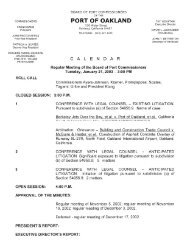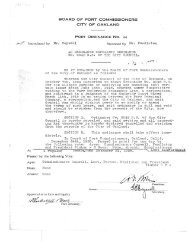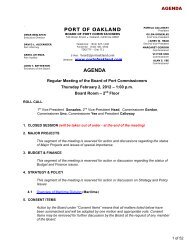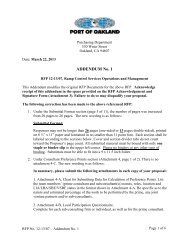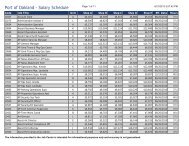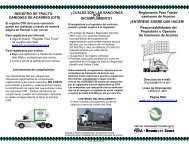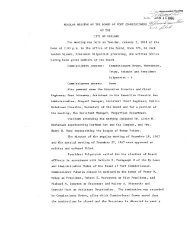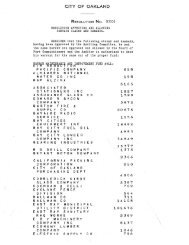Port-Wide Sewer System Management Plan(SSMP) - Port of Oakland
Port-Wide Sewer System Management Plan(SSMP) - Port of Oakland
Port-Wide Sewer System Management Plan(SSMP) - Port of Oakland
Create successful ePaper yourself
Turn your PDF publications into a flip-book with our unique Google optimized e-Paper software.
Chapter 7<br />
OVERFLOW EMERGENCY RESPONSE PLAN<br />
This chapter describes the <strong>Port</strong> <strong>of</strong> <strong>Oakland</strong> (<strong>Port</strong>) Overflow Emergency Response <strong>Plan</strong><br />
(OERP), which provides measures to protect the public health and the environment in the<br />
event <strong>of</strong> a sanitary sewer overflow (SSO).<br />
7.1 REGULATORY REQUIREMENTS<br />
7.1.1 San Francisco Bay Area RWQCB Requirements<br />
The San Francisco Bay Area Regional Water Quality Control Board (RWQCB) requires that<br />
each wastewater collection system agency develop an overflow emergency response plan<br />
with the following elements:<br />
• Notification: Provide SSO notification procedures.<br />
• Response: Develop and implement a plan to respond to SSOs.<br />
• Reporting: Develop procedures to report and notify SSOs per SSO Monitoring and<br />
Reporting Program.<br />
• Impact Mitigation: Develop steps to contain wastewater, to prevent overflows from<br />
reaching surface waters, and to minimize or correct any adverse impact from SSOs.<br />
7.1.2 SWRCB Requirements<br />
State General Waste Discharge Requirements Order No. 2006-0003 (GDWRs), issued by<br />
the State Water Resources Control Board (SWRCB), specifies that a <strong>Sewer</strong> <strong>System</strong><br />
<strong>Management</strong> <strong>Plan</strong> (<strong>SSMP</strong>) must include an Overflow Emergency Response <strong>Plan</strong> that<br />
includes, at a minimum, the following:<br />
a. Proper notification procedures so that the primary responders and regulatory<br />
agencies are informed <strong>of</strong> all SSOs in a timely manner;<br />
b. A program to ensure an appropriate response to all overflows;<br />
c. Procedures to ensure prompt notification to appropriate regulatory agencies<br />
and other potentially affected entities (e.g. health agencies, Regional Water<br />
Boards, water suppliers, etc.) <strong>of</strong> all SSOs that potentially affect public health or<br />
reach the waters <strong>of</strong> the State in accordance with the monitoring reporting<br />
program (MRP), the California Water Code, other State Law, and other<br />
applicable Regional Water Board waste discharge requirements or National<br />
Pollutant Discharge Elimination Program (NPDES) permit requirements. The<br />
<strong>SSMP</strong> should identify the <strong>of</strong>ficials who will receive immediate notification;<br />
d. Procedures to ensure that appropriate staff and contractor personnel are aware<br />
<strong>of</strong> and follow the Emergency Response <strong>Plan</strong> and are appropriately trained;<br />
e. Procedures to address emergency operations, such as traffic and crowd control<br />
and other necessary response activities; and<br />
May 2010 7-1<br />
pw://Carollo/Documents/Client/CA/<strong>Port</strong> <strong>of</strong> <strong>Oakland</strong>/8239A00/Deliverables/Ch07 (FinalA)



